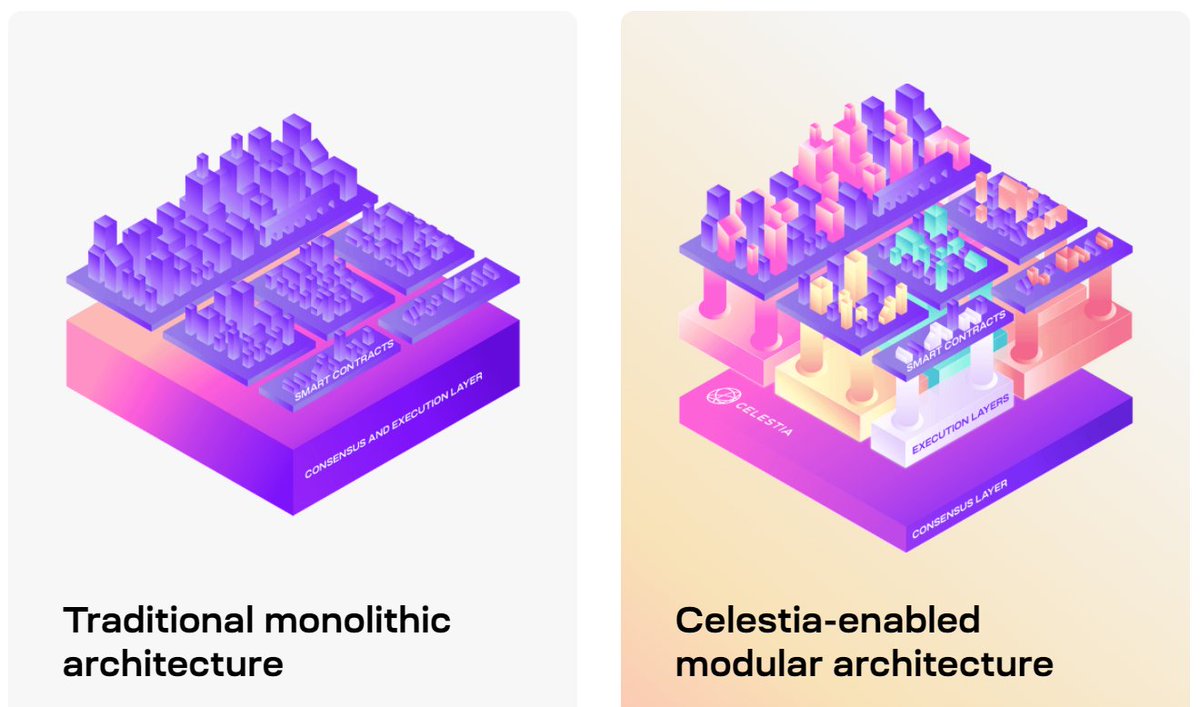
#Celestia in 5 tweets
Here are the most important things you should know about Celestia, the modular blockchain.
A thread 🧵👇
Here are the most important things you should know about Celestia, the modular blockchain.
A thread 🧵👇

1. Celestia improves scalability by separating the 3 core functions of a blockchain. Celestia is a modular consensus and data network, built to enable anyone to easily deploy their own blockchain with minimal overhead. 

2. #Celestia doesn’t have to execute every transaction that happens. Celestia just needs to make sure that the transaction data in the block is available. This is done through data availability sampling, which is incredibly scalable. It can be run on a phone.
3. #Celestia provides consensus and security on-demand. This enables anyone to deploy a blockchain without the overhead of creating a new consensus network. Celestia is essentially cloud computing for Web3.
4. Developers have the flexibility to define their own execution layers on top to form their own blockchains. This will allow for increased specialization and more efficient blockchains.
5. Because Celestia does not validate transactions, its throughput is not bottlenecked by state execution like traditional blockchains.
For a full guide to #Celestia, check out the 101 I wrote:
https://twitter.com/cryptoPothu/status/1506575358140641282
Accounts to follow for #Celestia insights:
@CelestiaOrg @analyticalali @menzel_clayton @sandraaleow @roopmai @0xRainandCoffee @CannnGurel @musalbas @jadler0 @nickwh8te @KreuzUQuer @renelubov @likebeckett @adeets_22 @cosmos_voice @fyhfyhio
@Cryptocito @0xMisaka @DCbuild3r
@CelestiaOrg @analyticalali @menzel_clayton @sandraaleow @roopmai @0xRainandCoffee @CannnGurel @musalbas @jadler0 @nickwh8te @KreuzUQuer @renelubov @likebeckett @adeets_22 @cosmos_voice @fyhfyhio
@Cryptocito @0xMisaka @DCbuild3r
More #Celestia accounts:
@AviFelman @0xKira_ @InternDAO @CryptoSeq @ShamanShiitake @omw_to_the_moon @0x_Osprey @SaintSat0shi @riabhutoria @larry0x @InvisibleB4 @techryper @tradeyapma @Cryptocito @sunnya97 @larry0x @pupmos @GoldenStaking @natashajuliakim @_juliettech @Lewwwk
@AviFelman @0xKira_ @InternDAO @CryptoSeq @ShamanShiitake @omw_to_the_moon @0x_Osprey @SaintSat0shi @riabhutoria @larry0x @InvisibleB4 @techryper @tradeyapma @Cryptocito @sunnya97 @larry0x @pupmos @GoldenStaking @natashajuliakim @_juliettech @Lewwwk
• • •
Missing some Tweet in this thread? You can try to
force a refresh





